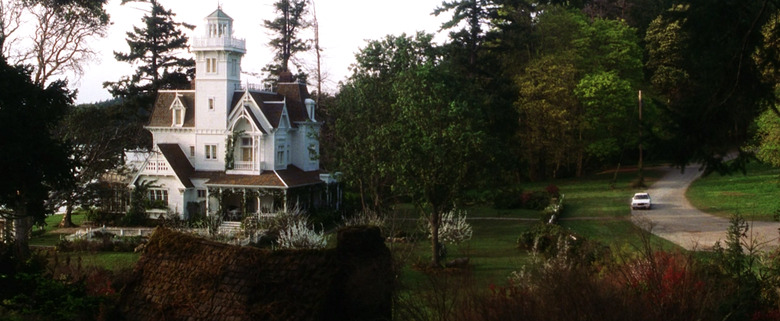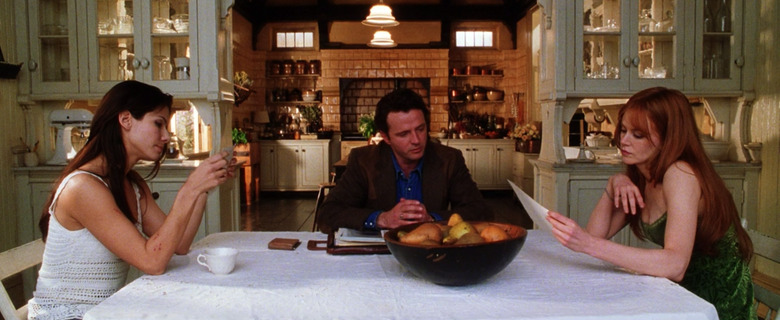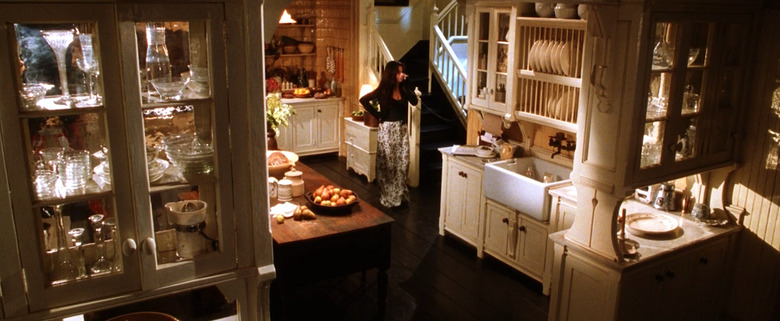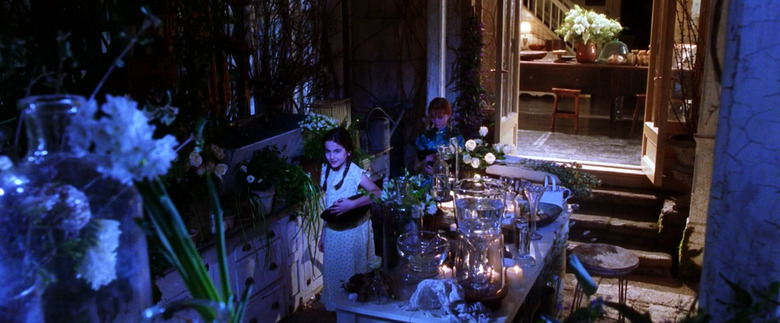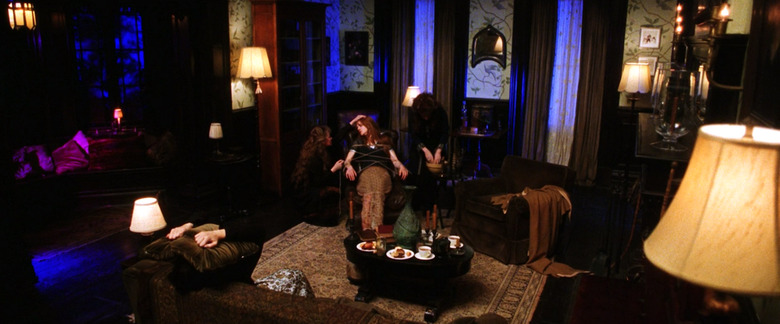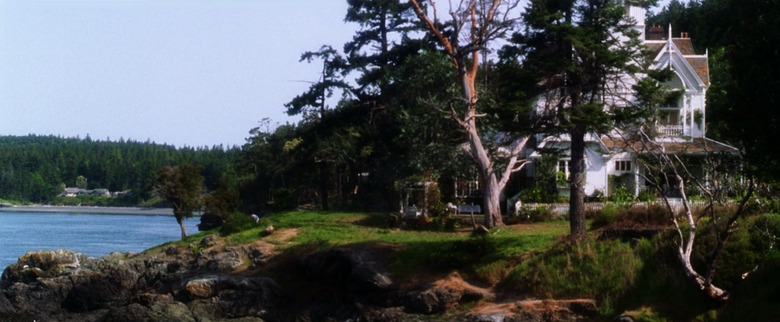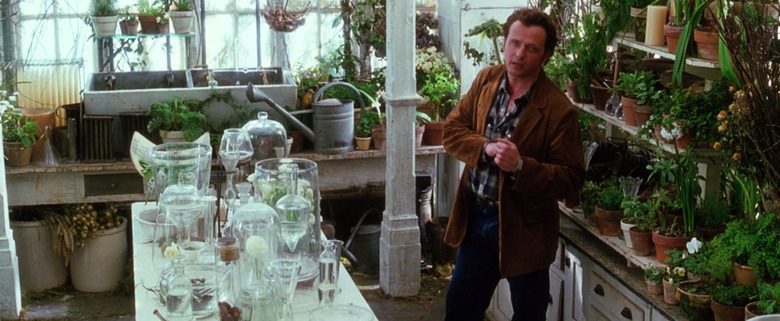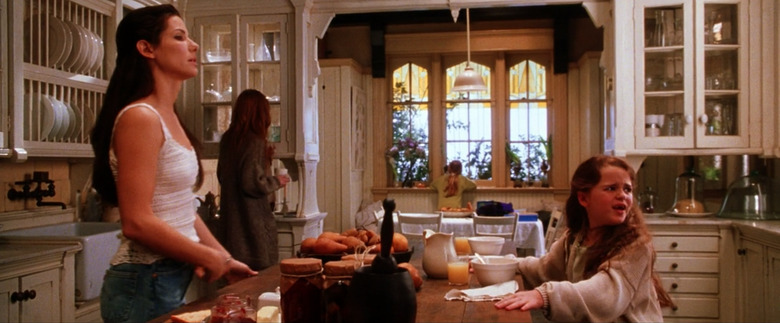The True Story Of The Home In 'Practical Magic'
Whenever October rolls around, certain Halloween movies are put on heavy rotation, whether it's Hocus Pocus or Halloween. One of these beloved spooky staples is Practical Magic, the 1998 fantasy rom-com about two sisters who come from a powerful lineage of witches. Based on Alice Hoffman's best-selling novel, Practical Magic tells the story about Sally and Gillian Owens (the grown-up versions are played by Sandra Bullock and Nicole Kidman, respectively) who are raised by their two eccentric witch aunts after both of their parents pass away (the father, from a family curse; the mother, from the heartbreak of losing him). The sisters try to navigate their witchy identities while growing up in a small, New England town, as their aunts encourage chocolate cake for breakfast and ignore "silly things like bedtimes."
There are many reasons to love Practical Magic, but one of the most mesmerizing parts of the movie has to do with where most of it takes place — the aunts' home. In the book, the house is described as "dark in every room, even at noon," with "no clocks and no mirrors and three locks on each and every door." In the movie, the house is much less macabre. When coming up with the look of the aunts' abode, production designer Robin Standefer, of the design firm Roman & Williams, envisioned a Victorian house inspired by East Coast shingle-style homes, complete with a widow's walk on top. "Women were traditionally light keepers and this was a house of women," Standefer said of the lighthouse detail in a 1998 interview with Victoria magazine.
Griffin Dunne, the director of the film, had mentioned in the DVD commentary that he and Standefer believed the witches had "incredibly great taste and probably read House Beautiful." They opted for something cheerful, avoiding anything that "reeks of occult," but also had great character, like the houses seen in films such as Giant and The Magnificent Ambersons: "That was our approach when we chose the design for the house," the designer mentioned. Standefer also told Victoria that it couldn't look haunted. "It had to be clean and white, not fading and cobwebbed." Forgoing any stereotypically witchy, Addams Family-like, goth decor, the Owens' home looked more like it belonged to Nancy Meyers than Nancy Downs.
In fact, whenever people talk about enviable movie kitchens, Practical Magic is usually right there next to Something's Gotta Give. The two kitchens share similar features, like white tile backsplash and an abundance of matching cream cabinets. However, Standefer made sure to include elements that would make sense in a home full of witches, like a pantry stocked with mysterious canned goods, and bottles of herbs and potions, as well as a long farmhouse table perfect for everything from candle-making to bringing a former lover back from the dead. The kitchen, which Standefer described as the "heart of the house," also features a stunning cream Aga stove, where both brownies and magical stews could be conjured up in an instant. "I remember being a little bit threatened by so many people telling me how much they loved the kitchen in the movie," Dunne told Vulture in a 2017 interview (in which he also described being cursed by the witch he consulted for the film!).
Another notable room in the house was the conservatory, where glass cloches covered every kind of herb, plant, and flower, and a young Sally collected ingredients for "Amas Veritas," a spell for finding her one true love. Dunne admitted in the DVD commentary that while the roses were artificial, everything else was real. "We had a greenhouse for our greenhouse," he said. "We had so much growing, plants, flowers, orchids ... it was like a floral shop every day." The conservatory would lead outside to a lush garden filled with even more greenery, although the blossoms on some of the trees were made of silk.
Other rooms in the home were more somber and spooky and had a rustic feel, such as the parlor, where the sisters would later gather a coven to banish an evil ex-boyfriend. Standefer decorated the room with antique leather chairs, velvet curtains, framed botanical specimens, and hand-painted vines and birds on the walls.
However, the most surprising (and disappointing) thing about the Practical Magic home is that it wasn't a real house — it was merely an "architectural shell" used to film the exterior shots. Standefer and her design partner and now-husband, art director Stephen Alesch, dreamt up the home in L.A. (with Alesch sketching the layout), and would spend six months constructing it on an island north of Seattle. So, while many other iconic movie houses can be visited in real life (the famous Halloween house in Pasadena, CA reportedly gets thousands of tourists seeking a scary photo op every year), the Owens' family home only exists in the world of the film, much to the dismay of fans.
One of the reasons why they had to build the house from scratch was because the producers didn't think they'd be able to find one that had everything needed to truly tell the story. But there was more behind the temporary facade. Dunne was scouting for shooting locations when he found the ideal spot, a bluff on the west side of San Juan Island that would be the perfect setting for the house. (The rest of the scenes for the fictional town of Maria's Island would be shot in nearby Coupeville.) There was one major caveat: Native American artifacts were found in the area, so it was suspected to be a possible burial ground. Dunne said the town would only let them shoot in the area as long as they didn't break any ground. "They didn't want the soil disturbed at all, so, not only is it on the bluff, but the house is on a platform." Dunne also described the aunts' garden as a "huge sandbox" that was placed on top of the ground so no soil was ever broken. The interiors were built on a soundstage at the Warner Bros. studio in Hollywood, however, they brought the entirety of the kitchen and greenhouse to Washington to shoot, as well.
The home was so realistically captivating, Barbra Streisand apparently called Standefer to inquire about buying it. "Everyone assumes we just found that house, which is just the kind of effect that you're going for," said Dunne, who also described it as a testament to Standefer's work. Bullock mentioned that since shooting Practical Magic, she'd gone through architecture books and found "pieces of the house." More specifically, she discovered which eras Standefer had pulled inspiration from. She also said that her own kitchen looks like the one in the film (though it's unclear which of her past homes she could be referring to).
On the last day of shooting before it came time to take down the house, Standefer made herself a salad from the garden — a bittersweet, goodbye gesture. Dunne said that by five o'clock the next day, it was already leveled. "It was very sad. I passed by and I couldn't look at it," he said. "It felt like I grew up in it."
All these years later, there's just something about the Practical Magic house that so many of us feel a connection to, even if it was purely fictional. "Today we think there is a separation between real life and magic," said Denise Di Novi, the movie's producer. "But if you analyze life, magical things occur every day."

